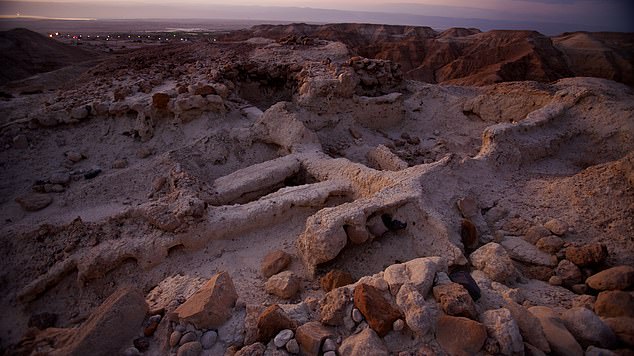Archaeologists excavating near Jordan’s southeastern Dead Sea have uncovered evidence that may link the biblical ‘sin cities’ to real historical sites.
The discoveries include Sodom at Bab edh-Dhra and Gomorrah at Numera, both showing Early Bronze Age occupation, fire-ravaged ruins and permanent abandonment.
Admah and Zeboim, associated with Fifa and Khanazir, also had signs of occupation and destruction, though further excavation is needed to confirm their identities.
Zoar, near modern Safi, stood out for its continuous habitation from the Bronze Age through the Byzantine period, with excavations uncovering churches, tombstones, Nabataean remains and a cave tied to an ancient prophet said to have pleaded for God to spare the city for his refuge.
Dr Titus Kennedy, a field archaeologist, shared on the Digging for Truth podcast that the findings at Zoar help anchor the biblical narrative and contextualize the destruction of the other cities.
All five sites follow a north-south alignment along hilltops near ancient streams, reinforcing the biblical account.
‘You’ve got five cities that potentially all look the same and the same types of things happened there in the right geographical area,’ Kennedy emphasized.

The discoveries include Sodom at Bab edh-Dhra, which is one of the famous wicked cities of the Bible

According to the Old Testament, these cities were destroyed by fire and brimstone as divine punishment for extreme wickedness, including cruelty, corruption and moral decay
‘And I think that is very compelling for identifying this with the five cities of the plain.’
According to the Old Testament, these cities were destroyed by fire and brimstone as divine punishment for extreme wickedness, including cruelty, corruption and moral decay.
Genesis describes Sodom and Gomorrah as places where ‘the outcry against them was so great and their sin so grievous’ that God decided to obliterate them.
A prophet, named Lot, and his family were spared because of their righteousness, with Zoar serving as their refuge.
The story has long been interpreted as a warning against immorality and defiance of divine law, giving the archaeological discoveries a powerful narrative context.
Bab edh-Dhra, the strong candidate for Sodom, contained cemeteries showing charnel houses burned from above, consistent with Genesis 19’s description of fire from heaven.
‘When they were excavating in the cemetery, they found that the charnel houses had been burned on the inside,’ Kennedy said.
‘Initially, they thought this might have been done to cleanse the grave so it could be reused.

Gomorrah is believed to be at Numera, as excavations found it had Early Bronze Age occupation, fire-ravaged ruins and permanent abandonment. The same was determined at Bab edh-Dhra
‘But as they continued excavating, they uncovered one particularly well-preserved example, including the roof.
‘Upon further examination, they discovered that the fire had actually started on the top of the roof, burned through it into the chamber and then spread throughout.
‘This suggests that the destruction came from above, rather than being intentionally set inside the graves.’
Skeletal remains found at Numera, a proposed site for Gomorrah, were unearthed from under a collapsed tower, indicating a sudden catastrophe.
‘We don’t find a lot of intact human skeletons just lying around archaeological sites,’ Kennedy explained, noting that it is because ancient humans of this time typically placed the dead inside sealed tombs.
Both cities align geographically with Zoar and follow a north-south line of hilltop settlements near wadis, supporting the biblical narrative of the cities of the plain.
Despite some radiocarbon dates suggesting earlier destruction, pottery and other archaeological material fit the biblical timeline, reinforcing Bab edh-Dhra and Numera as plausible historical counterparts to Sodom and Gomorrah.
Limited cemetery excavations at Fifa and Khanazir suggested destruction patterns similar to those at Bab edh-Dhra and Numera, aligning with the biblical account of Admah and Zeboim’s fiery end in Genesis 19.
Kennedy emphasized: “They need to be excavated thoroughly officially to give us some more detailed and correct information,” underscoring the need for future research to confirm their identities.

Skeletal remains found at Numera, a proposed site for Gomorrah, were unearthed from under a collapsed tower, indicating a sudden catastrophe
Like Sodom and Gomorrah, these cities were likely abandoned after their destruction, fitting the biblical narrative of divine judgment on the cities of the plain.
Zoar, confidently identified near modern Safi, stands out as the only city spared destruction, serving as Lot’s refuge in Genesis 19.
Excavations over the past 30 years have uncovered two large Byzantine churches, a Roman fort, Nabataean habitation and Bronze Age pottery, confirming continuous occupation from Abraham’s time through the Byzantine period.
‘So far, there are two large churches that have been partially excavated. It’s certainly a significant Christian city at that period,’ Kennedy noted.
A key discovery was Lot’s Cave, located in nearby mountains, which Kennedy described as ‘pretty astonishing’ due to its Early and Middle Bronze Age pottery and a Byzantine church with inscriptions linking it to Lot.
‘They found pottery from the early Bronze Age and the beginning of the Middle Bronze Age, and then it ceased to be used for millennia. And so, it fits the correct time as a cave in use during the life of Lot,’ he said.
Ancient sources, including the 6th-century Madaba Map and 1st-century historian Josephus, who noted that ‘the Dead Sea extended as far as Zor of Arabia,’ corroborate Zoar’s location.
A tombstone for a bishop named Opsis, dated to 369 AD, and referenced by pilgrims like Egeria, further affirms Zoar’s enduring significance.
‘This is one reason why Zoir is very important … because we know where Zor is still. It’s definitely established because it was never lost to history,’ Kennedy said, highlighting Zoar’s role in anchoring the locations of Sodom, Gomorrah, Admah, and Zeboim.
This article was originally published by a www.dailymail.co.uk . Read the Original article here. .

